Notes for Alvart’s Pandorum (2009)

Publicity poster design for Pandorum
Citation for the film here
- Synopsis of Pandorum (Alvart, 2009)
- A short summary of the film by time
- Themes, motifs and mise-en-scene
- Discussions of the film
- Relevance to focus questions
- Resource list
Synopsis of Pandorum (Alvart, 2009)
Alvart, C. (Director) (2009). Pandorum. Screenplay and story by Milloy, T. UK: Constantin Films.
The population of Earth has continued to grow and by 2174 it exceeds the carrying capacity of the planet. Earth builds an interstellar ark called Elysium and 60,000 people volunteer and are eventually brought on board, bound for an Earth-like planet named Tanis. The Elysium used a reactor power source and the journey is meant to take 123 years.
The passengers and Elysium’s crew are in hypersleep in individual pods where they are connected to umbilicals that feed and nurture them. The crew is on a hypersleep rotation to cover the journey, with successive crews taking over to manage the Elysium, After eight years of this mission the Elysium receives a transmission, saying , “You’re all that’s left of us. Good luck, God bless, and godspeed.”
Two Elysium crewmembers, with uniforms labelled Corporal Bower and Lieutenant Payton are awakened from hypersleep due to fluctutations in power from the ship’s reactor core. The traumatic awakening seems to have caused amnesia for both men. The unstable reactor means they cannor leave their cabin space normally so Bower ventures up and out through a ventilation duct to see what can be done and where the current crew may be. Bower has flash-backs of wanting to join the Elysium and remembers his wife, who he hopes is in hypersleep in a passenger area. Bower learns that one result of hypersleep and interruptions to the process can be illogical panic attacks that are called ‘Pandorum’, a severe psychological illness that caused an earlier captain of another ship to jettison his crew and passengers into space to die.
While be explores, Bower is attacked by a woman who wants to knock him down and take his flight boots. Noises are heard down the dark corridor and the woman runs away. Bower learns as he hides that there are pale-skinned humanoids decorated with tribal markings. They are cannibals with heightened senses for smell and they carry primitive weapons. Bower just escapes from the cannibal pack when he meets another member of a different, later crew. Mutant cannibals attack and the crew member is taken and eaten but Bower is saved by Manh, a Vietnamese hydroponics worker who has combat skills. He meets again the woman, now learning she is Nadia, a geneticist who lives in her lab, where genetic materials for Earth’s livestock are available.
Bower convinces Manh and Nadia to accompany him to the fusion core and Payton has set out separately to access the bridge of the Elysium and he meets Corporal Gallo, who seems deranged and shocked and believes the ship is lost in space. The humanoids attack Bower and Gallo and they escape into a chamber where a ship’s cook has been living for some years. Gallo remembers that he killed his rotation crew because they developed Pandorum and Gallo believes Payton also shows symptoms of this condition. The cook, Leland, invites them to dinner and explains the murals on his chamber walls. The murals depict Gallo’s madness after hearing of Earth’s disappearance. Gallo manipulated others with Pandorum to platy a game of battle and cannibalism. The decendants of Gallo’s murderous and insane game evolve while Gallo returns to hypersleep. The rapid mutation of the Pandorum gangs is due to those in hypersleep to assist them adjust to Tanis by accelerating their selection or fitness. The Pandorum mutants have adapted instead to the Elysium, gaining senses to assist their hunting and fighting.
Bower’s team fall unconscious, drugged by Leland but Bower’s insistence that the whole ship will be destroyed in less than an hour sees Leland change his mind and release the team, who head out for the reactor through the passengers’ hypersleep areas. As they travel Bower remembers more and knows that his wife left him on Earth. He also remembers more about Payton in sudden, jagged flashbacks with rapid dialogue and jump-cuts from a close up of Bower’s face and back to past narrative.
The fusion reactor that needs restarting turns out to be the main lair of the Pandorum cannibals. After nerve-end creeping about, the mutants are roused and Manh sacrifices himself to save the others. The reactor is restarted and this kills many mutants and Manh dies when he is fooled into thinking a humanoid child was harmless and suffers the consequences. A final piece of the beildering narrative falls into place when Payton and Gallo fight and a dose of sedatives jerks Gallo into the understanding that he is, in fact, Gallo. At around the same, rapid and jerky time Bower’s loses his amnesia and realises that Payton is Gallo, the insane murderer.
On the bridge Gallo opens the shutters over the windows but there are no stars and Bower himself trips into a manic Pandorum state. Gallo tries to manipulate Bower into continuing the murder game. Amidst noise, confusion, rapid cuts and wild hallucinations, Bower recovers some of his senses and the bridge shows that the Elysium was launch 923 years before and Nadia sees that there are bioluminescent creatures beyond the windows and both Bower and Nadia realise that they are already on Tanis and have been underwater on their destination planet for 800 years.
Water floods into the ship and the cabin and Bower flees with Nadia to a hypersleep pod. The Elysium reacts to the disaster of the hull breach that ejects all the active pods. Bower and Nadia’s pod reaches the surface of an ocean on a very beautiful planet with beaches and waterfalls and rainbows, as well as the requisite multiple moons. Many pods come up from the Elysium and a narrative window scrolls the information that this is Year One on Tanis, though it is actually Year 801 for them, and that there are 1,213 survivors from the original crew of 60,000.
A short summary of the film by time
Timeline:
- Titles loom up, “1969 Man Lands on the Moon / World Population = 3.6 Billion” at 00:44.
- 01:10 “2174 The Battle for Earth’s Limited Resources Reaches Its Boiling Point / Spacecraft Elysium is Launched” title.
- 02:05 Nice still of zooming into model aft cockpit.
- 02:19 Message “You’re all that’s left of us. Good luck. God bless.”
- 02:50 Jerked awake with music and visuals after female mouth mimes, “I love you.”
- 03:11 Bower human in Bower module awakens.

Image of Bower awakening in his sleeper pod.
- 04:21 The lights go out as Bower figure pulls out plugs and tries to stand.
- 04:47 Bower figure finds empty suspension chamber for Cooper and Pavlo chamber with someone still in it.
- 05:30 Tremulous music with Bower’s trembling hand. Very dark and partially lit.
- 06:07 Bower reads exercises to do for illness resulting “from extended hyper-sleep.”
- 06:42 Bower hammers on Lieutenant Payton’s sleep cubicle.
- 07:22 Bower uses a sort of mini blow torch to shave. Nice graphics.
- 08:01 Lieutenant Payton seems to awaken. He is also disorientated.
- 09:38 Both characters remember very little but some things are remembered and they try to reach others.
- Crawling through air vents at 12:33.
- At 13:25 a spider spins down a narrow thread in the ventilation shafts, full of darkness and cables/tubes.
- Payton thinks they have been asleep for 8 years (at 15:10).
- At 16:11 Bower finds a corpse in the same jam-locked position he is in. “I found Cooper, he’s dead.” He loses contact with Payton at 17:15.
- Bower looks for Payton but cannot reach him on the radio. At 18:23 he sees another person, just a glimpse in the dark and steely blue/black.
- At 19:18 Bower finds the Hanged Man in the corridor suddenly with a full, shrill trumpet-synth noise. Then the music goes to fast, high-end squiggles like violin notes discordant running up and down.
- At 19:37 Bower is knocked down from behind but gets up again. At 19:58 the scantily clad woman in glistening black plastic holds the curvy knife to Bower’s throat and says “Don’t move!” very sternly. She tells him to take off his shoes.

Image of the biologist as Post-Apocalyptic heroine
- At 20:33 more insect noises and the woman goes. The hanging corpse is taken and Bower runs, picks up the light-stick and sees flashing, nasty movement at 21:36.
- The mutant-looking pale humanoid searches for Bower and there are many cruelly-spined shadows on the walls in the poor light at 22:08.
- At 22:50 the pale mutant humanoid tries to spear Bower through the grill where he is hiding.
- At 23:45 Bower says they took Cooper’s body, “They didn’t seem human.”
- At 24:05 Payton says “Out here there is no rescue and there is no turning around.”
- At 24:25 Payton says “Sixty thousand people on a single launch trajectory”.
- 24:58 Flash-back to media of the discovery of an Earth-like planet and a young boy standing in a stupid black cassock to hear the news. He looks like Bower. At 25:24 the probe on the planet says “…this is an unprecedented moment for all mankind …some form of plant-life” and then “My God, life on Tannis” at 25:36. Bower remembers the Elysium was taking settlers and then remembers his beautiful partner. Bower remembers their girlfriends and wives are here, somewhere aboard. They are to breed on Tanis.
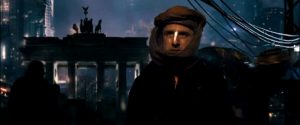
Image of Bower learning of the survival flight to Tanis.
- Bower wants to find his partner but Payton says to take control of the ship first, at 27:32.
- Payton, back with the pod area tried to coordinate the movement to allow Bower to get to the power plant at 28:53.
- At 29:09 Bower’s hand shakes again and he tells Payton, who remembers the Eden Mission, where there was a hyper-sleep malfunction that meant an officer had a breakdown (we see the Eden at 29:42) from a condition they now call Pandorum so the officer evacuated what he thought was the evil ship at 30:03. “He launched them all into oblivion”.
- At 30:38 Payton talks Bower up to the power plant. At 31:17 he finds a different hanging body, booby-trapped to the ceiling. The body comes awake and struggles with Bower. The officer is from Flight Team 06 who are meant to follow Bower and Payton. He is wearing Shepard’s uniform. Shephard knows nothing, also.
- At 33:27 Shepard covers himself with grease and muck to disguise his scent and refuses to obey Bower. “There’s no fucking order on this ship,” he says.
- At 34:20 Bower and Shepard cower from the nasty mutants with spikes. Shepard is taken and killed gruesomely and Bower runs, chased by leaping mutants. He loses his gun in a fall and is being wound-in when a new, caped figure with a spear emerges and cuts the line to save him. He is human.

- The swarthy figure is with Agriculture but speaks a different language at 36:55.
- At 37:50 back in the pod room Payton tries to get out. At 38:46 Payton has a nose bleed.
- At 39:22 in one container among many Bower is attacked and it is the woman from the early scene, the geneticist Nadia, who roughs him up. He is about to be stabbed when the Agriculture worker turns up and he battles her.
- The three leave as a team at 41:20 but there are problems. She asks him “Can you fly and land the ship?” and Bower says “Yeah”.
- At 43:49 they just make it inside a lit corridor while the Mutants attack.
- She lives in an Ecological Development area, that is powered at 44:13. She was part of a five-person sampling team. We see lots of racks of specimens at 44:47 and she says “This, truly is, Noah’s Ark.”
- Bower says “This was a 123 year flight.” At 45:52 she gives him a grasshopper to eat “Good for protein”. She says “This ship was built to outlast our children’s children. I think we’ve been asleep longer than you think.”
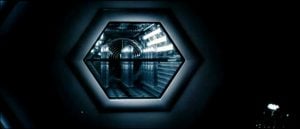
An image of seried tubes of DNA to bring Earth life to Tanis.
- Back in the pod room a crew member reaches out to Payton at 46:58. It is a well-preserved crew member looking greasy and dirty but he can speak. He says he is Flight Crew. He is naked and cold and says his name is Corporal Gallo, from the Bridge. He is disturbed but has very good teeth.
- Back with Bower they are in a huge chamber where there are many more pods. The Agriculture worker stays behind and Bower falls, followed by the woman Ecologist. They are in a sort of sewer area with lots of bits of corpses, a revolving horizontal fam and a mutant watching them at 50:38.
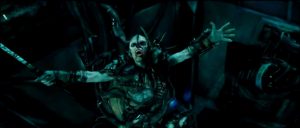
Image of the exultant mutant king summoning his troops.
- They escape at 51:52 and are attacked by a Mutant who is about to kill the woman when Bower attacks him. There is an unlikely fight with much bellowing from an almost indestructible Mutant and it is killed at 53:44. Other mutants eat the killed Mutant.
- At 53:35 As they run from the horde of mutants a crew member awakens and is immediately attacked by the Mutants. The King Mutant stabs the newly awakened through the head and looks happy in a rougish, clownish fashion at 54:57.
- At 55:38 Payton back in the pod room has the naked awakened man and reads his arm tattoo, saying he is indeed Flight Crew. Payton interrogates Gallow who said someone had Pandorum and he had to defend himself. They have a weird conversation with several mad stares and half-smiles.
- At 57:55 the three arrive at a chamber where there is another English speaker. They eat the Cook’s food and talk in sappy ways with Bower and the Ecologist. She thinks the enzymes released in the ship to adapt to the new world have run riot and the Mutants have adapted to the ship instead. Bower asks, “So you think those things mutated?” at 1:00:41. Again, she says the passage of time is much longer than he believes from his hibernation.
- Cut back to Payton with his new, rather intense guest. They talk about Pandorum (Orbital Dysfunction Syndrome) and left this at 01:01:31. Payton is asked “Do you know the symptoms of Pandorum?” and he looks panicked.
- Nice images of the Elysium in space above a planet at 01:02:24 as the new Flight Crew officer rants at Payton. We cut back to the three with the Chef and he seems very deranged, also, describing the flight and the disaster at 01:02:47.
- Rapid cuts between the scenes as both lunatics tell the story of how Earth is gone at 01:03:42. The tales in both places are strange and dislocated and we see gas let out on the trip with the Chef as he tells them one self-appointed leader stayed on and led lunatics who started to cannibalise the crew at 01:05:14.
- There are several quick scenes including Bower leaving his wife/lover and the ship shaking and Payton freaking out and shaking at 01:06:02.
- The three awaken upside down with the chef nearby and he says “It’s not personal guys, it’s just survival.” at 01:06:30.
- At 01:09:41 Bower convinces the Chef to let them go and he does. He contacts Payton and asks him for some technical stuff and Payton agrees. They hear there is less than 46 minutes left before complete system failure. They head on to the fusion reactor.
- At 01:10:02 they come across a Mutant child and they say, “The bastards are breeding” and the child escapes and stirs up the King Mutant who screams and calls for troops. Many short, action cuts with pounding hard music. Payton tries to help Bowers and says “He can do it” to save the ship. Bowers remembers his wife/lover left him and did not come on the flight. We see a few flashes from a windy, Dark Earth when Bowers is rugged up watching an ad for Elysium at 01:12:24. Bower seems to be standing at the Brandenberg Gates or very like.

Image of Bower learning of the survival flight to Tanis.
- 01:13:12 the Ecologist Nadia gives the pep speech saying “We’re meant to go on and now it’as more important than ever.” Bower says he remembers Payton’s wife.
- The four journeyers find the nuclear core “the Citadel itself” at 01:14:47.
- We see the reactor core has an odd, metal bridge across to it. It is dark and has arcs of electrical energy and there are hundreds of nakedish Mutants lying down and sleeping at its base at 01:15:47.
- At the core the walkway breaks and Bower starts to fall into the Mutant sleeping horde but the Ecologist grabs his hand and saves him at 01:16:02. At 01:16:42 the core panel opens to show a simple code sequence input by whacking on coloured cones to get into the core proper.
- Back with Payton there are arguments and shouts and building music. The Corporal holds a metal beam and asks “Who is the one being delusional?” at 01:17:23.
- The Corporal has a gun at Payton’s neck and he is bleeding extensively from the nose. Payton says “It wasn’t the crew who were sick, was it?” at 01:18:36. The Corporal seems to be the Captain and he calls Payton ‘Corporal’.
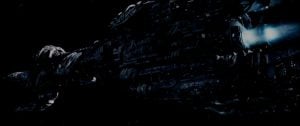
Image of the Elysium powering through space.
- Bowers is crawling over the Mutant horde and they awaken when a torch falls and all start climbing and running up to the others but the reactor restarts at 01:22:24.
- At 01:23:15 the Vietnamese Agriculture officer Minh faces off for a fight with the King Mutant, shaping up like a boxer. In sporting fashion the King Mutant throws him a spear and then attacks with a mighty leap and they battle. The King Mutant is speared but continues and Bowers and the Ecologist run through long, dark corridors. In a very gruesome scene the King Mutant is biting into Minh’s kidneys and is knifed repeatedly in the head and then loses it and dies at 01:25:00. The child is back and Minh is about to kill it but it gives a pretty smile and he stops so the Mutant child slashes his throat and Agriculture is no more.
- Payton battles with the bloody-mouthed Corporal or Lieutenant in the control room at 01:25:46 and then we see that Payton is actually just battling with himself. There is no other person present, perhaps, and he injects himself with sedative and comes around.
- The Cook arrives and is ragged and tired but instead of talking a new, stern Payton injects him in the eye and this seems to kill the Cook.
- Bowers and the Ecologist continue to run from screaming Mutants at 01:26:59 and a seemingly happy Payton makes his way to the Bridge.
- They make it all the way back to the command section and the Ecologist asks “Where’s your Lieutenant?” and Bowers answers “He’s not my Lieutenant” because now he remembers everything, or thinks he does at 01:27:18.
- Bower and the Ecologist make it to the Bridge at 01:27:30. They see a withered corpse in one of the Flight Deck’s chairs and Bower finds the Flight Log on a handy computer screen and learns the truth at 01:27:40. Bower finds the Lieutenant in a dark chair and asks him who the Hell he is and he answers ‘Gallo’. Bower accuses Gallo of murdering the crew and causing the disaster.
- Gallo opens the main observation windows for the Bridge at 01:28:37 and it is blackness. Behind Gallo at 01:28:50 we see a digital display reading Mission Year 92. Gallo gives a strange speech about losing the chains and giving yourself ultimate freedom. Gallo talks about Pandorum as Bower seems to be becoming increasingly deranged with the Mutants about to rush in and eat them and no stars above in the viewing ports.

Image of the computer screen noting the final passage of time: 923 years.
- Gallo tells Bower to “let go of your petty concept of reality” at 01:29:53. Gallo says “This ship is the seed from which we can create a new world” and Bower tells him to shut up. Bower seems a bit crazy also and pulls out some pliers and sticks them in Gallo’s mouth and says he will pull the sick out of you. The Ecologist Nadia is looking up at the display ports and looks a bit worried then she calls Bower over and they hear whale song and see luminescent stingrays of vast size at 01:30:55.
- Cut to an outside shot of the Elysium and it is clear the ship is under water. We see another view of the digital display and it is now clear that it reads ‘Elysium Mission Years 923’. At 01:31:05.
- Gallo is back and yells at Bower from behind and says the ship can land itself but does not float too well at 01:31:17. Gallo is beating up Bower when the Ecologist Nadia attacks him, apparently with a long knife she has kept nearby. They struggle and Gallo is about to kill the Ecologist when he takes aim with the pressure wrist device and fires at a Mutant climbing in but a nut is knocked loose and it hits the Observation Windows and they start to crack elaborately.
- Bower comes to his senses and grabs the Ecologist and water floods in and covers Gallo. Signs flash ‘Warning Hull Breach’, then ‘1,211 Life Pods Active’ Total 60,000 at 01:33:32. Bower lifts the Ecologist Nadia into a pod as water fills the Bridge. They are in Corporal Bower’s pod again but there is a nasty Mutant grunting outside the pod. They are fired out up through the water and we see the submerged Elysium.
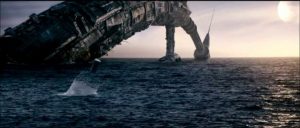
The escape pods pop out of the sea from the partially submerged Elysium.
- At 01:35:03 at last we see beyond the Elysium curved hull out in the open air and the pod comes out and opens.
- They see the outside of the Elysium and more and more pods come out. It is a planet with a great big pinkish Moon and a lovely sudden coastline very nearby the Elysium’s crash site. The camera pulls back and we see many people coming up out of the Elysium but also a beautiful, verdant blue planet where they can breathe the air, apparently. We keep pulling back and see that the blue planet has two Moons and a sun and there is a caption for the planet ‘Tannis Year One Population 1213’.
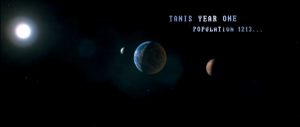
Image of the final title: Tannis in Year One. Only 1213 have survived from the original 16000.
Themes motifs and mise-en-scene
Themes in the film:
A theme in a film is similar to a theme in a poem, short story or novel and is described in a simple form as, “A film’s theme is what the film is essentially about. The theme of the film is conveyed through its narrative, the behaviour of the characters and the style of the film.” (Caldwell, 2014, p180). Some themes are described in the quotes section, below, but the audience can always find their own themes and these can be defended with evidence from the visual text.
Themes dominant in Pandorum (Alvart, 2009) might be:
- memory – the loss of personal and societal memory are crucial in this text
- humanity’s adaptability
- opposed to this, the human need for repeated patterns, rather than the new or novel
- the barbarity at the centre of all human nature, exposed by the space illness Pandorum
- the essential need for humans to band together to accomplish societal goals
- the willingness of an individual to sacrifice him/herself for the common good and regardless of the odds, keep striving
Motifs:
Just as in a novel or shorter narrative a motif is a “distinctive recurrent element” (Chandler & Munday, 2016). Some motifs are found frequently in the genre of Science Fiction (SF), such as the protagonists search for answers, a planet, a person or a place in deepest space. In the sub-genre of the Generation Spaceship within SF some motifs are found across many texts, such as the vast array of stars seen through a visor or a transparent shell. The repetition of the motif leads it to “acquire a ‘ symbolic ’ significance” (Chandler & Munday, 2016). For a visual text such as a film, Caldwell (2014, p.18) describes a motif as “anything that is used repeatedly in a film to define or explain a character or to suggest a theme. Sounds or musical phrases can also be motifs.”
Motifs in Pandorum (Alvart, 2009) are:
- the male protagonists search for answers, seen through rapid and loud flashback scenes (discussed in the ‘Mise-en-scene’ section, below)
- awakening traumatically from a cryosleep or HyperSleep in a pod, as if it were a birth into a nightmare (or in the resolution, a birth into a fertile delta),
- and pronounced physical characteristics like spasms, shaking hands, shaking heads wide-eyed and the protagonists’ vision jumping from perceived reality to flashback or hallucination.
The last point is discussed in more depth in the next section.
Mise-en-scene and tropes:
For analysis of films, the French term ‘mise-en-scene’ is often used. Mise-en-scene are “all the elements within the frame of the film” (Caldwell, 2014, p.133) such as setting, lighting, costume, acting style and Computer Generated Imagery (CGI).
A trope in a novel or shorter narrative is a figure of speech “especially one that uses words in senses beyond their literal meanings” (Baldick, 2015). Tropes in formal argument could be metaphors or rhetorical questions but in the genre of Science Fiction they are a “familiar, metaphorical, and/or rhetorical figure of speech or way of telling a story” (Harcup, 2014). Some tropes of SF film narratives are devices, such as space shuttles, fusion engines and virtual reality displays that shortcut the process of explaining what these actually do or how they work. Instead, the viewers accept them as part of the SF furniture and move on with the narrative itself, unless the trope is a vital part of the story.
There are several tropes evident in Pandorum (Alvart, 2009), especially because it blends the SF and Horror genres. Most of the viewers will recognise these from other, earlier films, such as the Alien series begun by Ridley Scott (1979), such as:
- monstrous shadows lit suddenly or fleetingly from the point-of-view of a protagonist in a cramped space
- a late-industrial set of both high-tech and low tech machines amongst dark shadows and a little movement
- the vast caverns of an abandoned machine factory or within the machine itself
- a dirty, gritty and wet series of cramped apertures through which the protagonists must creep sudden
- escape in a mechanised technology that does not quite deliver the protagonists to safety
- awakening to a grey and incomprehensible world from a claustrophobic hypersleep pod, and
distinctly derived from the history of GS narratives:
- a problem with a main reactor that requires a protagonist or small team to repair the problem
- a dangerous, degenerate crew now barbaric but originally derived from the cargo or embarkation crew
- passengers on the spaceship who simply do not know they are on a spaceship
- a murderous cult dominates survivors that grew after the spaceship suffered a major mishap or rebellion, and dramatic inclusions of missing narrative elements to update the survivors of the spaceship to what is really going on and what has really happened.
Linked to this last point is perhaps the most obvious aspect of Pandorum (Alvart, 2009), the cinematography. As seen in the ‘Discussions’ section, below, a major theme of the narrative is memory loss and regaining lost memory. The director of Pandorum (2009) has used very dramatic, fast edits with very rapid scenes run together to show the protagonist gaining vital memories. These are hallucinatory flash-backs, sometimes with hand-held cameras or drastically altered lighting, sound and blink-rapid jump-cuts. Critics of the film are divided as to the success of the strong, stylistic elements (see ‘Discussions’ area, below) but viewers tended to agree that this was ‘pastiche’. A pastiche is a work of visual art, literature, theatre, or music that imitates the style or character of the work of one or more other artists. Unlike parody, pastiche celebrates, rather than mocks, the work it imitates. This website looks at GS narratives, rather than styles of direction so the reader is left to their own resources to trace back the sources of celebration for Pandorum (Alvart, 2009).
Discussions of the film:
In The Generation Starship in Science Fiction Caroti (2011) discusses the tropes of the Generation Starship and these can be found in Alvart’s Pandorum (2009) clearly. These tropes include “the persistence or loss of memory, both social and personal; the transmission of knowledge, values, ethical principles, and goals from one generation to the next; and the effects of prolonged isolation inside a man-made container of limited size -a prison, in other words” (Caroti, 2011, p125). While Caroti (2011) does not deal with Pandorum (Alvart, 2009) itself, his notes on memory are central to this horror/SF film. Caroti argues that, the “perennial preoccupation of generation starship narratives” [is the] “retention or recovery of memory” (Caroti, 2011, p121). Pandorum (Alvart, 2009) focuses on both amnesia from the prolonged hyper sleeps taken by the surviving crew as well as the terrible space illness of Pandorum that brings early symptoms of seizures and trembling then paranoia and finally psychoses.
As this horror/SF film depicts the horror of the plight of the few crew left pitted against the mutants who have evolved on-board the Elysium it is also clear that this texts follows Caroti’s (2011) argument that the generation Spaceship acts as a theatre of memory “for the dramatic exploration of the relationship between … ancestors and descendants” (Caroti, 2011, p142). In this case the crew work through amnesia to remember their mission’s goal to populate the planet Tanis with humankind but must first escape the clutches of those infected with Pandorum and the radically evolved mutants, the descendants of the early colonists. As with several other GS narratives, those who regain their fractured memories after prolonged hyper sleep act as societal and cultural memories of humankind at its best, while the descendants who live only for their brutal and cannibal society within the Elysium can show humanity (or a close proximity) at its worst.
The best of the critiques of Pandorum (Alvart, 2009), Muir (2010) parallels Pandorum with Heinlein’s Orphans of the Sky (1963) where in the latter “the vast vessel Vanguard, bound for Proxima Centauri became pilot-less en route; and the passengers and flight crew aboard her separated over time into distinct classes or sects (like the mutants or “muties.”) They even forgot they were aboard a ship…”
Muir (2010) notes that the Elysium is bound for the only habitable planet, Tanis. The crew receive a message “You’re all that’s left. Good luck and god speed”. Then the Earth is gone, perhaps through nuclear annihilation or an asteroid strike. Muir draws a comparison also with Dr Who, as in The Ark in Space (Bennett, 1975) sub-human monsters use the cryo-chambers as their feeding ground. “These beasts were once ‘sleepers’ and colonists themselves, but the synthetic accelerator that was pumped into their cryo-chambers (to help them adapt to life on Tanis) has instead adapted them to life aboard the ruined, out-of-control, Elysium”(Muir, 2010)
Muir’s (2010) review is strong and positive and he encapsulates the narrative as “Pandorum is pandemonium” and “this movie is madness, violence, madness, more violence, and more madness, until you feel whiplash. It’s all a bit exhausting.” While he was refreshed by its originality and the way the narrative took the viewer through recovery from amnesia, he believed Pandorum is “stuffed with one narrative u-turn too many” but Muir has always enjoyed “stories like the one dramatized here: stories of lost and imperiled space arks, of generational ships bound for disaster. I love the intriguing concept of cultural identity, heritage and history forgotten; and the accidental birth of a new social order, one based on the environment at hand” and overall “Pandorum may ultimately be a derivative riff on a familiar, oft-told science-fiction tale, but at least it isn’t a remake, a re-boot or a re-imagination” (Muir, 2010)
In his Film Ireland review McGlynn (2009) applauds Pandorum (Alvart, 2009) as “meticulously designed and planned” and Pandorum’s protagonists “are likeably tenacious and their growing ingenuity and confidence help them to develop into rounded, human characters.” As to the development of the narrative, McGlynn adds that the “back-story is revealed organically, via revelations and memories”. Overall it is a “bold synergy of great ideas that sync remarkably, and transcend its genre” (McGlynn, 2009).
The notion that Pandorum (Alvart, 2009) is a sort of blend of Horror and Science Fiction genres was found in several reviews and perhaps these would find parallels with Life (Espinosa, 2017). Anchor Bay (2017) believed the film to be “unflinching vision of terror ” and stressed its focus on memory as “a horrifying descent into madness for a pair of astronauts who wake up in a hypersleep chamber, disorientated, with no memory of how they got there” (Anchor Bay, 2017). In The Continuing Voyage Praska (2013) noted that “Pandorum is an excellent little science fiction/horror film”. Echoing almost all positive reviews, the strength of Pandorum (Alvart, 2009) was the way that the diminishing amnesia moved the narrative forward, “What sets Pandorum above other films with similar concepts is how the plot evolves along with the characters” (Praska, 2013). The trope of cultural or institutional memory opposed to the evolved memory of the terrifying descendants of the Elysium relates directly back to the genesis of the GS narrative.
Relevance to the focus questions
The focus questions for the GS Project are:
- What is worth holding onto over the generations?
- What should be discarded for the voyage? and
- Can life be sustained in the GS …or on Earth?
The relevance of the focus questions to Pandorum (Alvart, 2009) are less clear than in many, other GS texts, even though one of the main themes of this narrative is memory, both individual and social/cultural and memory is a central element in all GS texts used in the GS Project.
Simply stated (and perhaps this is safer for a SF/Horror text), what is seen to be worth holding onto is the importance of individual and group relations, seen in the surviving relationship of the protagonists. Also retained was the need to serve the common good, to fight against all odds and to keep hope alive. These trite admonitions may, indeed, be the basis for many SF and Horror texts and here they abound, even though their communication is marked by a desperate slip into madness, then sudden sanity and hope.
As in many SF texts, what is advocated to be discarded are scientific advancements that may overreach human nature or ability. One of these technological advancements is Hyper Sleep or cryosleep, a trope in GS texts. In this case, compounded with factors that are uncertain in this text, the suspension pods of cryosleep can induce Pandorum, the dreadful and rapidly deteriorating illness that leads to pyschoses of many types. With this is included the wish to take on God-like powers by rapidly evolving some passengers on Elysium so that thjey are more ready to live and survive on Tanis. This meddling with natural evolution results in the ‘mutants’ or cannibal tribes that roam the Elysium and seem to treat this spaceship as their entire world. The meddling with God’s powers is hubris or excessive pride and self-confidence, relating directly back to Dr Frankenstein’s sewing-together of his revived corpse in Shelley’s Frankenstein; or, the Modern Prometheus (1818).
Clearly, life can not be sustained on the Elysium as it is ruled by a demonic tribe of cannibals where, necessarily, the food source diminishes each year. However, the Elysium carries a collection of plant and animal genomes as a sort of Ark and while it is not clear if this is also delivered into the beautiful and apparently benevolent Tanis, it is at least possible. The Elysium’s surviving ecologist did breed insects as food, though this was not seen as a large-scale food resource and can not be described as sustainable. Ultimately, Tanis itself is seen to be able to sustain human life and offer hope as the protagonists find a rich ocean, green pastures, breathable air and many other favourable conditions, not including another apex predator to match humankind.
Resource list
Alvart, C. (Director) (2009). Pandorum. Screenplay and story by Milloy, T. UK: Constantin Films.
Anchor Bay Entertainment (2017) Pandorum DVD. USA: Anchor Bay. Accessed 030715 from http://www.anchorbayentertainment.com/projects/details/pandorum
Bennett, R. (Director) (1975) The Ark in Space. Dr Who TV Series, Season 12, Number 2, Parts 1-4. Written by Holmes, R. UK: BBC One.
Caldwell, T. (2014). Film Analysis Handbook. Cheltenham, Victoria: Insight Publications.
Caroti, S. (2011). The Generation Starship in Science Fiction: A Critical History, 1934-2001. USA: Mcfarland. ISBN 978-0-7864-6067-0.
Espinosa, D. (2017) (Director) (2017) Life. United States: Columbia Pictures.
Harley, K. (October 2, 2009). Pandorum Review. Online at gamesradar.com/pandorum-review. Accessed 030715.
Heinlein, R. (1941). Universe. In Astounding Science Fiction. May, 1941.
Heinlein, R. (1941). Common Sense. In Astounding Science Fiction. Ocotber, 1941.
McGlynn, Jack (October 29, 2009). “Pandorum Review”. Film Ireland. Retrieved 2009-11-01 from http://filmireland.net/2009/10/29/pandorum/
Muir, J.K. (2010) Cult Movie Review: Pandorum (2009). In John Kenneth Muir’s Reflections on Cult Movies and Classic TV Website. Accessed 8 August 2015 from http://reflectionsonfilmandtelevision.blogspot.com.au/2010/02/cult-movie-review-pandorum-2009.html
Praska, J. (June 19, 2013) Somnio: New, Independent SciFi Project from Travis Milloy. In The Continuing Voyage. Accessed 030715 from https://thecontinuingvoyage.com/2013/06/19/somnio-new-independent-scifi-project-from-travis-milloy/.
Scott, R. (Director) (1979) Alien. USA: Twentieth Century Fox.
Shelley, M. (1818) Frankenstein; or, the Modern Prometheus. London, UK: Hughes, Harding, Movar and Jones.


